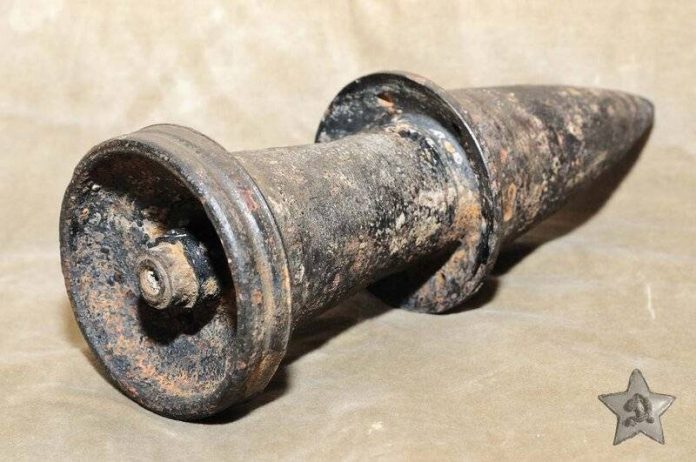
"Wolf foam" from Portugal
As is known, in the Soviet Union learned of the tungsten German know-how after the counteroffensive near Moscow. Then, in the hands of Soviet specialists were secret piercing anti-tank missiles with unusually solid core. I found their Military Engineer 3 Rank Vladimir Boroshev, When scouring the outskirts of Moscow stores of captured enemy equipment in late February 1942 of the year.
New ammunition were found from the new anti-tank gun ammunition (gun) 2,8 cm s.Pz.B.41 with a unique conical barrel. Caliber compact gun slipped to the muzzle with 28 mm 20 mm. Thus such miniature gun contrived to close successfully hit any medium tanks, and with luck and heavy KV.
in winter 1942 in the Soviet Union we were already aware of a very good armor penetration of new German shells and asked for help in unraveling the metallurgists to the Moscow plant named after Stalin. The results of crystallographic and chemical analysis showed, that the core sabots. made of superhard compound - tungsten carbide WC.
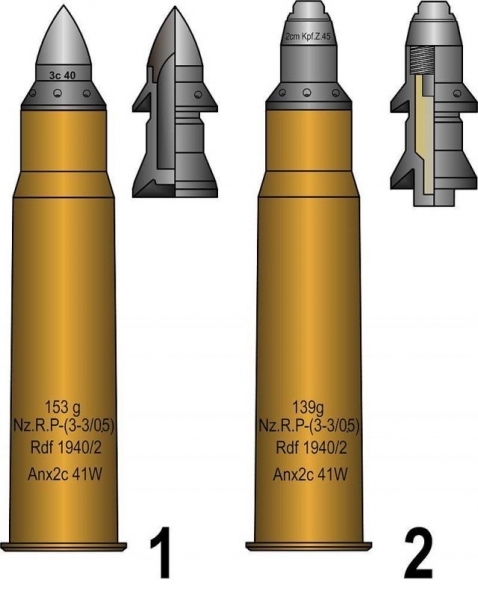 Piercing projectiles for 2,8 cm s.Pz.B.41. Left - anti-cored WC, Right - fragmental
Piercing projectiles for 2,8 cm s.Pz.B.41. Left - anti-cored WC, Right - fragmental
The literature is sometimes erroneously indicate, that the Soviet gunners were tipped projectile Pzgr. 41 H.K. from the more powerful anti- 7,5 cm Pak 41 with a tapered barrel, but this is not true. Krupp plants produced limited (150 copies) batch of these expensive tools only in the spring 1942 of the year. They are in the vast majority were sent to the Eastern Front, where almost all perished and. As a trophy gun 7,5 cm Pak 41 with six shells hit in the Red Army until the end of summer 1942 of the year.
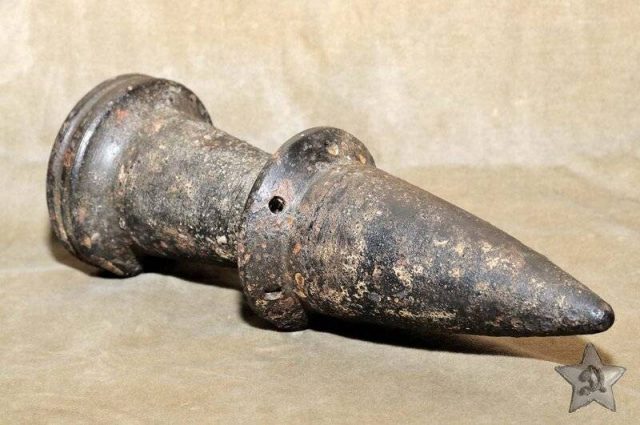
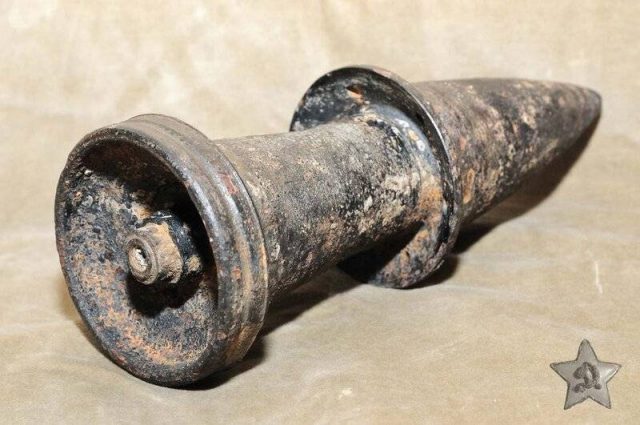 Rare piercing projectiles Pzgr. 41 H.K. from a unique gun 7,5 cm Pak 41
Rare piercing projectiles Pzgr. 41 H.K. from a unique gun 7,5 cm Pak 41
But back to the tungsten carbide. According to the Mohs scale of hardness is a unique substance reaches 9, giving this only to diamond with its maximum possible "tens". Along with high density cores compound and refractoriness of a material proved to be excellent anti-tank shells excipients. The average tungsten carbide contains up 94% precious metal.
If you know, the industry of Nazi Germany produced about two million piercing projectiles only for anti-tank guns with a tapered barrel, you can imagine the level of the needs of the Third Reich in tungsten. At the same time its own reserves of the rare metal of the Germans was not. Who do they take the ore for tungsten (with him. "Wolf foam")? The main supplier of the strategic importance of the material was neutral Portugal.
At the same time the Germans were so interested in tungsten, they were ready to buy it for the gold. Evaluate the role of Portugal during the Second World War is very difficult. One side, the leadership of this country and help Allies to lease an air base in the Azores Lanezh, and on the other - selling and Germans, and tungsten ore to enemies. At the same time, the Portuguese had virtual monopoly in this market sector - in those days they controlled up 90% all the natural resources of the refractory metal in Europe.
It is worth saying, Hitler even before the war, tried to accumulate at as much as possible of tungsten, but by the beginning of the invasion of the Soviet Union, these reserves are exhausted. The leader of Portugal's António Salazar, economist and lawyer by profession main, time offered his services to Hitler and the industry has not lost. tungsten price during the war jumped several times and began to bring small European country fabulous income. AT 1940 Salazar was sold per ton of ore 1100 dollars, as early as 1941 - for 20 thousand. trains, loaded enriched tungsten ore, We went to Germany through occupied France and neutral Spain.
According to some reports, banks in Lisbon by tungsten payment settled at least 44 tons of gold, Branding the Nazi swastika. Allies strongly demanded from the Portuguese to stop the supply of strategically important resource for Germany, especially the pressure intensified, when the Soviet Union discovered the mentioned anti-tank missiles. But in fact, the Portuguese tungsten supply chain has dried up only 7 July 1944 of the year, after three years of speculation with the Nazis.
However, the German arms industry has to 1943 It was felt serious "hunger tungsten" and significantly reduced the production of ammunition with superhard core. By this time, the Allied intelligence services were blocked and the other sources of supply of tungsten from China, North and South America. In total, Portugal earned at least World War II 170 million. dollars at the rate of 40-ies. The gold reserve of the country by the end of the war increased 8 time. One of the main debtors backward once the state became the UK. The British still had yet to pay for deliveries of Portuguese tungsten.
Nazi Germany was willing to pay dearly for tungsten. This provides certain advantages artillery Germans battlefield. However, the "wolf foam" was not the only metal, behind which the Germans had to literally fight.
"Cursed Molly"
During the First World War, tungsten is used for alloying steel armor, but the needs of the front several times higher than the possibility of extraction of refractory metal. And then the engineers decided, that will be an excellent substitute for molybdenum «wolf foam». Value added in the entire alloy 1,5-2% this metal, and now it appears expensive tungsten is not needed in tank armor.
In molybdenum for this refractoriness it has appropriate viscosity and, who acquired special importance in the artillery. But in the smelting of shells, and in the manufacture of trunks Krupp guns. The famous "Big Bertha" ("Big Bertha"), who were capable of firing at targets at a distance 14,5 km shells weighing 960 kg, They have been possible without doping with molybdenum steel.
The unique properties of the metal was, that he gave were not only strength, but also eliminates the inevitable fragility. That is, before curing molybdenum steel always accompanied by increased brittleness of the alloys. It is considered, As for 1916 , the Entente did not suspect the German technology of mixing molybdenum steel weapon. Only when the French were melted at random trophy gun, it turned, that the composition has a small share of the refractory metal. Second Reich proved vital this "vundermetall", but Germany was not prepared for a protracted war, however limited stocks prepared magic molybdenum.
And when he ran out, I had to turn our gaze on lonely molybdenum deposit at Mount Bartlett back in Colorado. Notably, that in the late XIX - early XX century, and no one really knew, what you can do with mine molybdenite open here. More 20 molybdenum years worth mere pennies. But everything changed the First World War. The owner of the field was kind of Otis King, which 1915 year world market managed to bring down molybdenum invention of a new method for producing molybdenum. He was able to get out of the ores 2,5 tons of metal, and it covered half the world's annual consumption. prices have fallen, and King was close to bankruptcy.
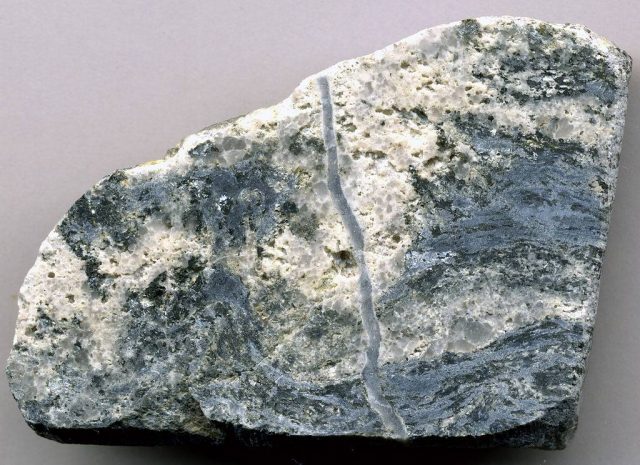 molybdenite ore. If the Germans did not get access to it, the shelling of Paris «enormous» would become impossible
molybdenite ore. If the Germans did not get access to it, the shelling of Paris «enormous» would become impossible
To "help" came the official representative of the German company Krupp Max Schott, that extortion and threats forced the King to sell mine for a measly 40 one thousand dollars. So, after hostile takeover, at 1916 year formed the famous company Climax Molybdenum Company, which is under the noses of the Americans (or with their consent) supplying valuable alloying metal to his home in Germany.
Until now, historians argue about, whether the firm Max Schott delivered, bypassing the owners of the group Krupp molybdenum English and French. Howbeit, Climax to the end of the war smelted from a molybdenite 800 tons of metal, and to 1919 year molybdenum prices have fallen so, the mine closed. Many workers were relieved - so difficult the working conditions in the mines of Mount Bartlett. Illiterate miners barely even able to pronounce the name of the metal, so they gave him the label of "damned Molly" («Molly be damned»), that was in tune with the English Molybdenum. Mine opened again 1924 year before 1980 , she worked continuously - wars on the planet quite enough.
/Yevgeny Fyodorov, topwar.ru/












